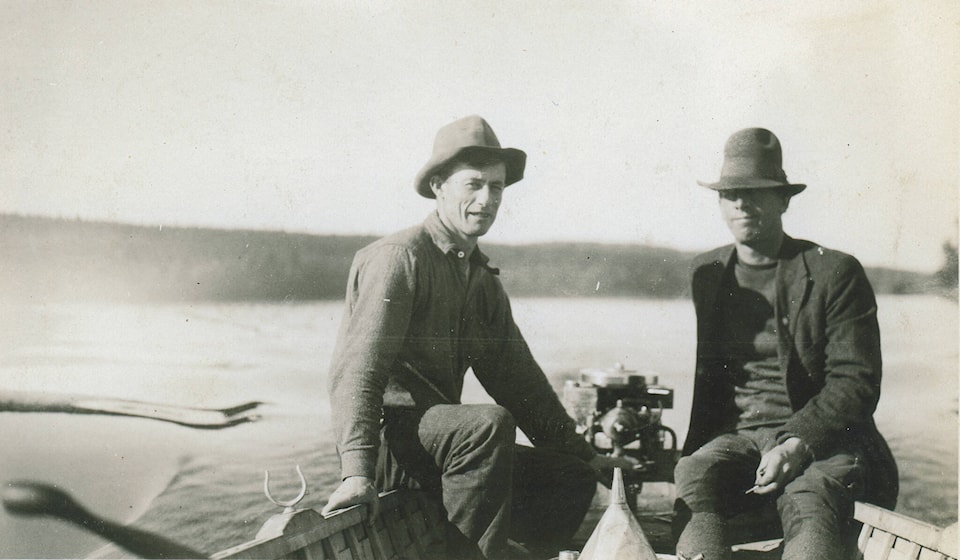Many of the first white men to settle the north shore of Francois Lake were trappers who lived alone in small cabins. Isolated from each other, their homes linked by a rudimentary pack trail, most used the lake as a highway and lived according to their tenets. For this reason, by the time government officials began constructing a proper road to Colleymount in 1926, those who hadn’t succumbed to cabin fever or simply disappeared (sometimes without a trace) were fairly set in their ways.
Arthur Ramsay was a bachelor who took up residence in 1913 on land once preempted by Bill Herkelraad, an old-timer who vanished around 1907 while running a trap line at the end of the lake. In later years, people remembered Ramsay for his boat-building skills—he and Harry McLean constructed the scow that served as Francois Lake’s first ferry—and his ability to survive despite himself.
Ramsay, it is said, once set blasting powder under a stump to dynamite it, lit the fuse, and then absentmindedly sat atop his intended target. The charges went off on schedule, throwing him into the air. He survived the mishap, but not one that occurred later and was allegedly related to his principal hobby: making homebrew in four-gallon gasoline cans.
When Ramsay’s house burned down, taking him with it, his neighbours poked through the debris in an attempt to discover the cause of the fire. Several concluded that the forgetful shipwright had accidentally placed four gallons of gasoline, thinking they were filled with brewing mash, atop his wood stove to cook.
A former resident of the area had another version of events.
Jasper Stanyer, whose family homesteaded near Brown Road in 1919, went to live with one of his sisters so he could attend school at St. Paul’s United Church along Francois Lake. His sister was married to Jack McLean, the man carrying the mail from Francois Lake to Wistaria by horse and wagon.
According to Jasper, a mysterious trunk carefully secured with rope arrived in McLean’s consignment of mail a few years before Ramsay’s disappearance. Because the item lacked a forwarding or return address, the postman had no option but to hold onto it. Sometime later, when no one had claimed the package, McLean grew curious and opened it.
Inside the trunk was an alcohol distillery. Not a homemade still, mind you, but an expensive, manufactured one made of bright copper, the likes of which had never been seen in the Lakes District.
The still became a communal asset, and was passed from one old-timer to the next until, says Jasper, it came into the possession of a bachelor named Tom Humphrey. After making himself a batch of moonshine, Humphrey turned the device over to Ramsay.
When word of the fire at Ramsay’s cabin spread through the community a short time later, Humphrey hastily made his way to the still’s last known location. He arrived ahead of the police and found the device’s copper coil protruding from the ashes of Ramsay’s home like a curled tombstone. The cause of the accident was obvious. Humphrey, perhaps not wanting to be implicated in the demise of his friend and fellow distiller, stomped the evidence into the ground.
The police failed to uncover the truth. In the weeks that followed, residents of Colleymount mourned Ramsay. If any of them secretly lamented the loss of the still, they refrained from making their grief public.
Jasper, in recalling the story of Ramsey’s demise, subsequently remembered Wiggs O’Neill’s boat and the barge that served as Francois Lake’s ferry.
The legendary Skeena River captain transported his launch to �������� Lake, where it was loaded on skids and dragged to Francois Lake by Amross Blayney’s oxen and three teams of heavy horses.
Bruce Little, captain of O’Neill’s launch, used it to tow the large scow Ramsay had built. This primitive ferry, based at Southbank, could be summoned to the north shore by raising a flag or hanging a coal oil lantern on the dock.
On one fateful occasion, the scow did the towing.
One summer morning, O’Neill’s launch and its attendant scow left Southbank with a team of horses and a wagon aboard. Partway across the lake, a big storm hit. Waves and wind buffeted the makeshift ferry. It missed the dock at Northbank, and nearly washed ashore east of the landing.
Residents removed the horses from the scow, then made a path to higher ground by felling trees and removing brush. Because O’Neill’s launch had been damaged irreparably in the accident, Little beached it in Church Bay. He salvaged the engines and put them in a larger boat, which remained in service for several years.
“The old hulk of O’Neill’s boat,” said Stanyer in the late 1970s, “drifted around the lake for years.”
Just like the mysterious alcohol still.
Cutline: Harry McLean (left) and Tom Hunphrey on the water in the first half of the twentieth century.



